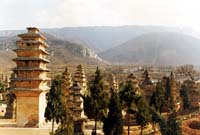
A group of 22 specialists on Friday gathered in Zhengzhou, capital of central China's Henan Province, to discuss plans to repair the Shaolin Temple, the cradle of the famous Shaolin Boxing with a history of over 1,500 years.
The specialists were led by Luo Zhewen, president of China Society of Cultural Heritage and head of the ancient building architects with the State Cultural Relics Administration.
Chang Jianchuan, director of the Henan Provincial Cultural Relics Bureau, said they would take into account the development demands of the Shaolin Temple and would carefully design the residential quarters.
Details of the repair plan were compiled in October last year, said Shi Yongxin, abbot of the Shaolin Temple.
The key hall near the main entrance, minor halls, courtyards and roads would be completely renovated, while structures and steles not in harmony with the environment of a temple would be removed.
New buildings would include a pagoda for holy scriptures, a museum for Shaolin boxing, as well as halls for the study of scriptures and prayer.
The plan would be submitted to higher authorities of cultural relics for approval after the specialists' debate.
The repairs should be completed before the National Day, which falls on October 1, and will be ready for the first world traditional boxing contest scheduled to be held in Zhengzhou City.
The Shaolin Temple is located in the Songshan Mountain area, about 35 miles southeast of Luoyang City and 40 miles southwest of Zhengzhou, the provincial capital. Built in 496 in the period of the Northern and Southern Dynasties (420-581), the temple was originally constructed for the Indian monk, Bodhidharma, who came to China to spread Buddhism and introduced an Indian form of exercise. The Chinese monks that gathered as followers combined this with Chinese techniques to produce the unique form of "wu shu" or martial arts.
The militia monks of Shaolin gradually gained fame during the early Tang Dynasty (618-907) by helping Li Shimin, the second emperor of the Tang Dynasty, to overthrow a local feudal ruler who wanted to set up a separate government by force.
In addition to the main entrance, the temple has guest rooms, a Dharma Pavilion, the Baiyin Hall, the Ksitigarbha Hall, and a hall housing 1,000 statues of Buddha and murals depicting 500 arhats. Frescoes on the four walls of the Vairocana Hall record the history of the temple and its martial arts.
(Xinhua News Agency January 31, 2004)
|

